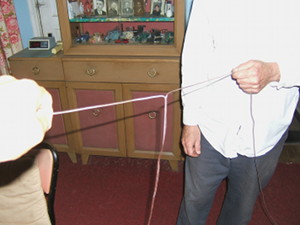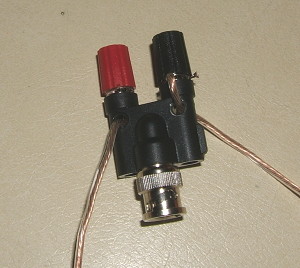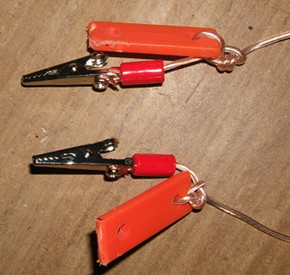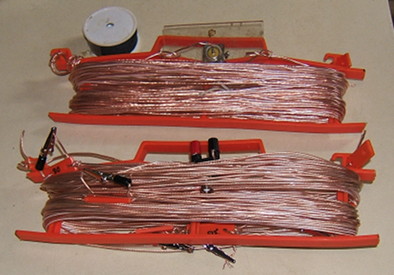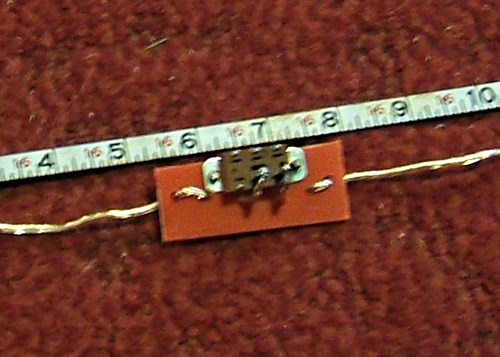Portable Operating
Although I operate QRP exclusively at home and portable, some folks think QRP is good only for QRP operation when they can't carry their big amps and antennas with them. That's well and good if they feel that way. I'm not writing this page to promote 100% QRP operation, but merely to share my experiences with operating portable.
If you call portable operation going out in the woods, to a park, or other such outdoor places, then I never operated portable until Tom WY3H invited me to go with him to his outdoor property and operate the QRP ARCI Hootowl Sprint in 2005. Before that I only operated away from my East High St. home from the apartment I had in Pittsburgh while I worked at WPIT, when I stayed with my late cousin over Thanksgiving weekend in 2003, and from the QTH of a friend, WN3JAI in Pittsburgh way back in 1967.
While operating in Pittsburgh, I got a second call of WA3IXO and used either that or K3WWP/3. Actually apartment is not really accurate. It was really just a rooming house where I simply had one room on the third floor. My rigs were a little transmitter that used a 2N3053 transistor if I remember correctly and some other transmitter that I don't recall now that had an input power of 7 or 8 watts. My receiver was an old Hallicrafters SW-500 with selectivity wide enough for an elephant to walk through. The antenna was simply an end-fed wire strung around my room which was maybe 10' x 10' at most. I think that setup even more so than what I am using now demonstrated that you can make QSOs with an extremely minimal setup. In 1967 and 1968, I made around 160 QSOs on 40 meters in some very limited operating time during my work week. On my days off, I came back here to Kittanning. Glancing through my portable log from those days, most QSOs were in the eastern USA. It looks like IA, FL, AR, and OK were my most distant states worked. All in all it was somewhat of a challenge to make QSOs, but the bottom line was I did make them.
Next up was my operation at my cousin's. I operated the 2003 CQWW DX Contest from there. That story is at contest_ss_03cqwwdx.html so if you want to read about it, take a detour there, then come back here.
My first few true portable operations have their own stories also as listed here:
2005 Hoot Owl Sprint - contest_ss_05hootowl.html.
2006 Hoot Owl Sprint - contest_ss_06hootowl.html.
I've also operated from several other venues since then, one of which is the submarine USS Requin moored near the point in Pittsburgh. I've done several operations from there with my friends Tom WY3H, Mike KC2EGL, Don K3RLL, Tom WB3FAE, Ken N3CU, Jon AB3RU, and WY3H's sons Ethan W3IRS and Ariel KC3AHO. All the venues we operate from are very interesting and enjoyable, but the Requin is especially so thanks to the sub caretaker Art WA3BKD. All of us have a great sense of humor and enjoy things a lot, no matter what, and Art fits that bill very well. During those operations we use the sub call of NY3EC or the NAQCC club call N3AQC. Stories of those operations including pictures can be found in my diary archives as follows around the given date or the following day or 2:
2009 August 13 - with Tom WY3H
2012 November 21 - with Mike KC2EGL
2013 September 12 - with Mike KC2EGL
2013 December 1 - with Tom WY3H and his sons Ethan W3IRS and Ariel KC3AHO
2014 August 14 - with Mike KC2EGL, Don K3RLL, Tom WB3FAE
2015 November 25 - with Mike KC2EGL
2016 April 17 - with Mike KC2EGL, Tom WB3FAE, Ken N3CU
2016 June 12 - with Mike KC2EGL, Jon AB3RU
2016 November 23 - with Mike KC2EGL
2017 June 19 - with Mike KC2EGL
2017 September 26 - with Mike KC2EGL
2017 November 24 - with Mike KC2EGL
2018 April 22 - with Mike KC2EGL
2018 June 3 - with Mike KC2EGL for Museum Ships on the Air weekend
Requin update. As of a couple years ago, to promote the Requin for the Carnegie Science Center instead of promoting QRP operation we use the Requin's equipment and operate with QRO power of around 100W. This helps to make more QSOs and keep the "Powers that be" at the Science Center happy. They seem to really appreciate our activating the radio room. We use NY3EC exclusively now and of course we only use CW as always. I keep my NY3EC QRO QSOs separate from my K3WWP records so K3WWP remains 100% QRP/CW.
Another venue I must mention in a little more detail is the Skyview Radio Society. Club members are great there, and unlike many clubs, the members don't put down CW and QRP. We also get a chance to experience something different by using their huge antenna farm with our KX3s and other rigs. I must especially mention Bob WC3O and Jody K3JZD who are fellow NAQCC members. We always look forward to running into them either at Skyview or various hamfests around the area. The description of Art WA3BKD from the Requin applies equally to them. As with the Requin QSOs, those from Skyview are kept separate from my K3WWP records because of the big antennas we use there. We use the NAQCC call of N3AQC there.
Including the above, I've operated away from my home shack at least 70+ times. A couple were not very far when Mike and I did Field Day from my front porch and yard.
I can truly say that all 70+ times have been enjoyable even though not all went as smoothly as possible due to an assortment of equipment problems or bad weather. All the equipment problems turned out to be learning experiences and a specific problem just about always never showed up again.
Mike and I had one really perplexing problem one time when we couldn't get one of our antennas to load at all. After a lot of head scratching and testing we found the problem was with a Pomona connector. I promptly grabbed it and threw it away into the woods where it may still be lying. Even the most basic piece of equipment can go bad. In retrospect we should have kept the connector to see just how it failed.
About the only really bad weather experience happened when Mike and I were operating N3A for our annual NAQCC Anniversary outing on Columbus Day. It just got so cold we couldn't even use our keys very well. We had to quit early that day.
One other thing comes to mind that's weather related. We had a deluge during Field Day a few years ago when we operated from some property of Tom WB3FAE in Chicora, PA. However we kept dry in Mike's tent and really only missed one beat. We QRT for safety's sake when there were some much too close lightning strikes for about a half hour. One of our antenna masts got tilted at a slight angle from the strong winds, but stayed erect. After the event was over, we learned that there was a tornado touchdown only about 20 miles from our site.
Let's talk about equipment for a portable operation. Anytime you operate out in the field, it is an excellent chance to use some very simple equipment. Unless you are almost a commercial operation with trucks to haul equipment, cranes to set up towers, and so forth, which some groups actually do for Field Day, a little rig like a KX3 and a simple wire antenna thrown up into a tree is really all you need along with some battery power to run the rig. Oh, and a paper and pencil to log the QSOs you will be making.
Over the years, I've used various rigs including a QRP+ borrowed from my friend Eric KB3BFQ, a K1 belonging to Don K3RLL that we shared on one outing, my K2, my KX1, and the best of all, my KX3.
I've also used a variety of antennas, some of which I don't even remember now. The ones I do recall are a 110' end fed wire, some shorter end fed wires, a vertical, and my favorite which is a jumper dipole set up in an inverted vee configuration. We call it the K3RLL antenna, since he introduced Mike and I to it, after which we built our own.
Since writing the above antenna info, it has changed and my antenna of choice is a 17 foot vertical with 4 ground radials from QRPGuys. It's easy to set up, and works well on 40, 30, and 20 by changing two jumper switches near the loading coil at the base of the vertical.
I've gotten a lot of questions about the K3RLL antenna, and I've decided to describe the antenna in more detail at the end of this page for those who may be interested. The description was originally published in NAQCC Newsletter #129. I've updated the description with the changes I've made since then.
I have been either throwing my antenna up into a tree using a golf ball launcher and my right arm, or borrowing a mast from Tom WB3FAE. Since then, I've bought my own mast from Jackite, as I don't like to borrow things and my good right arm is going to weaken as I get older. I now use the Jackite mast for the 17 foot vertical mentioned above.
I've used different batteries along the way. They included an automobile battery that Tom WY3H and I used for a Hoot Owl Sprint, a few different gel cells ranging from something like 2Ah up to 7Ah, a very large marine battery for one Field Day that I shared with Tom WB3FAE, a big battery power pack of Mike's that he bought originally to run his telescope, and a power pack that originally was designed to be an emergency auto starter battery which also included an air compressor to inflate flat tires. I bought it for a buck or so from a store here in town that some folks call a junk store, but I have gotten a lot of very useful things there at almost stealing prices. I had to do some work on it to get it to perform. The 18Ah gel cell that was in it wouldn't hold a charge, so I replaced it with a 17Ah one from a local Battery Warehouse. I removed the air compressor and rewired it a bit so it would work without the compressor. I also cleaned it up as best I could as it showed it had been used a lot. It easily ran the KX3 and PX3 for several hours between charges. That made it ideal for our four hour portable operations. It was a bit heavy but that doesn't really matter since we don't hike a long distance to our sites. We just drive as close as we can get, then walk the last 100-200 yards at most.
As with the antenna info, the battery info has also changed. Currently I use a Bioenno Lithium Iron Phospate 12V 6A 72WH battery that is very small and light. It measures 4 x 2.5 x 2.5 inches and weighs just over 29oz. It hards loses any power during our 4 hour portable sessions. I love it.
I think what makes operating portable so enjoyable is not the actual operating, but the fellowship with one's ham friends. I think without them, I'd find it rather boring.
Just some suggestions should you decide to try operating portable for the first time. First and foremost, plan the operation carefully and completely. Make sure you have a list of all the equipment you will need down to the smallest item. It's discouraging if you get to the site with something missing that you really need, especially if it is a long trip to the operating site. Keep that list and update it as necessary as you do more and more portable operating. It's a good idea to have the list in a form where you can check off the items as you gather them together and/or put them into your portable kit.
A kit can be as elaborate or as simple as suits you. Mike has a very nice case similar to a suitcase with a foam insert that can be cut to hold any sized piece of gear. In contrast, I use a simple sturdy cardboard box with smaller boxes to hold the KX3, PX3, etc. securely inside the main box.
If you announce your operation on something like our NAQCC spotter page, make sure you arrive well before the announced time as inevitably there will be some time-consuming glitches. It just seems to happen that way no matter how carefully the operation is planned beforehand.
Elaborating on the list of items, here is the actual list that I use here with notes following the list. Yours will be similar, plus or minus some items of yours. This list has evolved as I do more and more operations, and is still a work in progress as the saying goes.
KX3
PX3
PADDLE
STAND
BATTERY AND LEADS
POWER SPLITTER
ANTENNA
PL259 / BNC ADAPTERS
4 BUNGEE CORDS
JACKITE OMNI JK 22 POLE
COAX / PL259 / BARREL CONNECTOR / PL259
SHORT COAX FOR FILTER TO KX3 WITH BNC / PL259 ADAPTER
BAND FILTERS
SPARE CONNECTORS
POLE MOUNT
RADIAL WIRES
PERSUADER
RUBBER BANDS
CLIP LEADS
HEADPHONES
CLIP BOARD AND LOG SHEETS
PENS
CLUB HAT/SHIRT
WATCH/GLASSES
SMART PHONE
WATER
SNACK
CUSHION
PADDLE: or straight key, bug, sideswiper, keyboard, whatever you prefer. Also if the rig doesn't have a built in keyer, bring an external one for the paddle. Don't forget any cables needed to hook the keying device to the rig.
ANTENNA ADAPTER: Should you need something to connect say a PL-259 to BNC or the like. Very important if your coax is terminated in a different connector than what the rig requires.
COAX COUPLER: If you need to connect two or more lengths of coax together to reach from antenna to rig.
PERSUADER: Also known as a hammer or mallet for driving the pole mount into hard ground.
BATTERY AND LEADS: Be certain the battery has been fully charged the day before the operation. Of course don't forget the means to connect battery to rig.
LOG SHEETS: To log on paper
CLIPBOARD AND PENS: Clipboard to have a smooth writing surface. Don't forget the pens. Small items but can lead you to use some language you don't normally use if you forget them.
CLUB HAT/SHIRT: To promote your club if it's a club related operation and you want appropriate pictures.
WATCH/GLASSES: To log QSO times and to see the log should you be a glasses wearer.
SMART PHONE: The batteries will inevitably die just when you want that certain picture. So be sure they are fully charged.
WATER: You inevitably will get thirsty, especially if it's hot dry weather.
CLIP LEADS: Good to have along in case you need to solve some kind of problem.
This is a list that covers most of the locations we operate from. There are tables in our Community Park, but if you go to a place where there are no fixed tables, bring along a sturdy but lightweight folding table and a chair. You might also think about a tent or canopy if it is rainy or too sunny and hot.
This all may seem very basic, perhaps even silly to go to such extremes, but believe me, all the items are necessary to have a successful smoothly run operation. Just forgetting one can make for an unenjoyable outing.
The K3RLL Antenna Project
I am leaving this info intact although some of it may be outdated. There is just too much to edit.
Mike (KC2EGL) and I (K3WWP) were impressed by Don's (K3RLL) portable multi-band dipole antenna that the three of us used on one of our NAQCC portable operations at Kittanning Community Park and decided we'd like to duplicate it. The following is our attempt to describe the process including photos.
On one of Mike's many visits we got to work on the antenna for use on our portable N3A operation on Columbus Day and other NAQCC portable operations. The first step was to gather parts. The parts included alligator clips, stereo speaker wire, some kind of center insulator, coax, PL-259 and BNC connectors, extension cord wrappers, 10 foot Black Widow crappie pole to use as a mast, tripod base to support the mast, guy wires, and tent pegs.
UPDATE: Currently switches replace the alligator clips and a Jackite pole is used in place of the crappie pole.
We began by cutting to length and splitting the stereo speaker wire.We wanted the antenna to work on 80 through 10 meters. We started with the 10 meter segment since it was the shortest. For the center connector we used a BNC male connector with dual binding posts known familiarly as a Pomona Connector. We cut two lengths of wire to 8 feet 4 inches in length and fastened them to the center conductor to make the 10 meter dipole. When we say 8 feet 4 inches, actually we added about 5 inches to the wire to allow enough extra to wrap and fasten the wire to the insulators and/or center connector. That is true of all the dimensions mentioned below.
UPDATE: My current version is cut for 40, 30, and 20 and can be used on 17 through 10 also when set to 40 meters using the built-in KX3 tuner. The version using switches does not need the additional 5 inches of wire.
At each end of the dipole we put an insulator made from end pieces of the extension cord wrapper and connected an alligator clip to the end of the wire. The pupose being to have a point where we could connect another segment of wire for 20 meters.
UPDATE: Switches instead of alligator clips.
To extend the 10 meter dipole to 20 meters we needed two 8 feet 4 inches segments. We connected those to the insulators at the ends of the 10 meter dipole with the end of the wire bared so we could connect the alligator clip to it, thus making a 20 meter dipole.
This process was repeated for 30, 40, and 80 meters. Here is a table of the frequencies and the length of ONE HALF of the dipole. The third column is the length of the EXTRA wire to be added for each band. Remember to add the approximately 5 inches to each as mentioned above.
| 28.050 | 8' 4" | - |
| 14.050 | 16' 8" | 8' 4" |
| 10.110 | 23' 2" | 6' 8" |
| 7.040 | 33' 10" | 10' 8" |
| 3.560 | 65' 9" | 31' 11" |
At the very end we added another insulator without the alligator clip. This would be the point where we fasten fishing line to tie off the ends of the antenna to some kind of support such as a tree or tent pegs.
At a later visit we took a 100 foot length of coax and cut it into two 50 foot lengths. At one end of each we connected a BNC female connector and at the other end a PL-259 connector. While checking the continuity of the cables, we found it was very important to check the ends of the same cable, rather than the BNC on one cable and the PL-259 on the other. With wires and cables spread haphazardly in a small space, it took a little while to figure out that was the reason we weren't showing continuity one time. HI
The extension cord wrapper is used to neatly wrap up the antenna for portability and storage. At the bottom is the one described here. The top one is an extra 80 meters-only one we made for that band. You may notice it has a different center connector for no particular reason other than that was what was available in my junk box.
UPDATE: That "different center connector" is very similar to what I use on my current 40-30-20 meters version of the antenna.
On the day of the operation, we bought a couple of subs at Subway and took two antennas (the one we built and another one given to Mike by Don) up to Community Park here in Kittanning. We connected coax to the center of each dipole and fastened the center insulator to the tip of a fishing rod with a bit of fishing line and one of the snap swivels, mounted one rod in the tripod with the open end on a peg in the ground for more stability, and raised it to its full height. Only one had a tripod for mounting. For the other one we used 3 clothesline guy wires about half way up the rod, taping them to the rod with black electrical tape and fastening the other ends to tent pegs in the ground. We then stretched out the antennas and fastened the fishing line at the ends to more tent pegs in the ground.
All that was left now was to connect the antennas to the rigs. The one we built was used with Mike's KX-1, and the one that Don gave Mike was used with Mike's K2. Within a half hour or so of arriving at the park we were on the air.
Fortunately it was a much nicer day weatherwise than our N3A operation last year when we nearly froze. In fact it was downright beautiful with warm temperatures and partly cloudy skies. I say fortunately because we had a great deal of difficulty getting anyone to work us for whatever reason, and in a couple hours of endless unanswered CQ's on 40, 30, and 20 meters, only one QSO showed up in our logs thanks to Joe KD2JC. At least we enjoyed the nice weather and of course, the food from Subway.
The bottom line on the antennas is that they worked well despite the lack of QSO's, and were very easy to set up. There is only one thing we may modify. The tip of the fishing rod bent somewhat under the weight of the antenna. We may try using lighter wire in a future version or using some kind of a stiffer mast such as PVC pipe.
UPDATE: Of course as mentioned, we now use poles from Jackite as masts. They are much sturdier.
UPDATE: Here is another newsletter excerpt talking about the switches vs. alligator clips.
Here's a picture of one of the switches I used in the jumper dipole as described in yesterday's diary entry.
Since the original 2010 article, I've modified mine quite a bit. For the center insulator/connector I now use a SO-239 mounted on a piece of plexiglass to which I attach my coax line to the KX3. Instead of the alligator clips in the article, I now use small slide switches as the jumpers. I tweaked the lengths of the wire segments a bit. They no longer need the extra inches to connect to the alligator clips as described in the newsletter.
Some of the info on this section is redundant, but overall I think it should provide enough info for anyone to build a version of their own.


